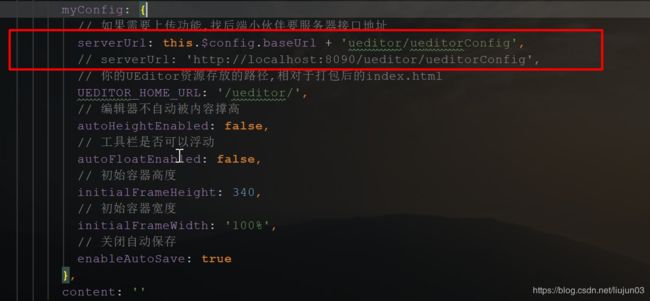Vue集成Ueditor的前后端实现
Vue完整前后台项目介绍
对比其他的富文本编辑器,Ueditor的功能相对来说是最强的,对于在Vue中集成Ueditor想必还是有这个需求的。
下面具体说下如何在Vue中集成Ueditor以及在后端如何进行配置提供上传功能。
我对比了多个在网上找到的方法,也分别做了实验,其中感觉最简便的是Github上网友提供的插件:vue-ueditor-wrap,他借用Vue提供的语法糖实现了数据的双向绑定,不用你自己去getContent或setContent
Github地址为:vue-ueditor-wrap
首先做下准备工作,从Ueditor官网上下载Ueditor完整源码以及Jsp版本
Ueditor官网地址为: Ueditor
下载好之后,将Jsp版本解压,解压后文件夹改名为ueditor,将文件夹中的jsp目录删掉,之后将整个ueditor文件夹拷贝到Vue的public目录下,我是使用vue-cli3.0创建的项目,没有static目录只有public目录,项目结构如下:
这是前期的准备工作,做完之后,开始安装vue-ueditor-wrap插件:
npm install --save vue-ueditor-wrap
安装成功之后,就可以尝试使用了
下面是我的测试页面 Ueditor.vue
步骤无外乎这几步:
-
引入
VueUeditorWrap组件import VueUeditorWrap from 'vue-ueditor-wrap' -
注册组件
components: {VueUeditorWrap}, -
v-model绑定数据
其中config是你根据自己的需求修改配置,
其中的UEDITOR_HOME_URL: '/ueditor/',这个配置很重要,一定得写对
这些都完成之后,就可以在页面上测试一番了。
这样的话基本功能就全都出来了,下面介绍下如何配合后台实现上传功能。
在前后分离之前用过Ueditor的就知道,要使用上传功能,首先后台得提供配置文件,之后就是提供相应的上传方法了,下面就上传图片做个介绍,其他的上传操作都是类似的。
在前面的准备工作中,我们把Ueditor的源码下载下来了,我们找到其中的这个jar包,将之解压后全部复制到后台工程中,其他的jar包在pom文件引入就可以了:
注意到这里资源目录下有个config.json文件,这是Ueditor上传功能所需的配置文件,这个文件在Ueditor-jsp版本的jsp目录下,找到将之复制到资源目录中。
现在将所需文件都复制好之后,就可以来修改源码来提供上传功能了。
原来Ueditor是通过访问上面截图中的controller.jsp文件来初始化配置文件以及进行上传操作的,我们现在将之用代码进行替换。
下面看一下我写的提供配置文件以及提供上传图片功能的源码:
package com.baiding.vue.controller;
import com.baidu.ueditor.ActionEnter;
import org.json.JSONObject;
import org.slf4j.Logger;
import org.slf4j.LoggerFactory;
import org.springframework.web.bind.annotation.RequestMapping;
import org.springframework.web.bind.annotation.RestController;
import org.springframework.web.multipart.MultipartFile;
import javax.servlet.http.HttpServletRequest;
import javax.servlet.http.HttpServletResponse;
import java.io.IOException;
import java.io.PrintWriter;
import java.util.HashMap;
import java.util.Map;
import java.util.UUID;
/**
* @Author: BaiDing
* @Date: 2018/8/30 11:58
* @Email: [email protected]
*/
@RestController
public class UeditorController {
private static final Logger logger = LoggerFactory.getLogger(UeditorController.class);
@RequestMapping("/ueditor/ueditorConfig")
public void ueditorConfig(HttpServletRequest request, HttpServletResponse response, MultipartFile upfile) {
response.setContentType("application/json");
String rootPath = request.getSession().getServletContext().getRealPath("/");
try {
String exec = "";
String actionType = request.getParameter("action");
if("uploadimage".equals(actionType) && !upfile.isEmpty()){
// 做图片上传操作
exec = uploadImage(upfile);
}else{
request.setCharacterEncoding( "utf-8" );
exec = new ActionEnter(request, rootPath).exec();
}
PrintWriter writer = response.getWriter();
writer.write(exec);
writer.flush();
writer.close();
} catch (IOException e) {
logger.error("UeditorController#ueditorConfig exception:",e);
}
}
private String uploadImage(MultipartFile file) {
JSONObject jsonResult = null;
try {
String fileName = file.getOriginalFilename();
String extraName = fileName.substring(fileName.lastIndexOf("."));
// 这里就是上传图片的具体逻辑了,原本是通过fastdfs来上传图片的,这里就简单生成个字符串假装上传成功了吧
// String url = FastdfsUtil.upload(file.getBytes(), file.getOriginalFilename());
String str = UUID.randomUUID().toString();
String url = "http://dfs.image.com/"+str+".png ";
jsonResult = new JSONObject(resultMap("SUCCESS",url,file.getSize(),fileName,fileName,extraName));
} catch (Exception e) {
logger.warn("UeditorController#uploadImage exception:",e);
jsonResult = new JSONObject(resultMap("文件上传失败","",0,"","",""));
}
return jsonResult.toString();
}
//{"state": "SUCCESS","original": "111.jpg","size": "124147","title": "1535961757878095151.jpg","type": ".jpg","url": "/1535961757878095151.jpg"}
private Map<String,Object> resultMap(String state, String url, long size, String title, String original, String type){
Map<String ,Object> result = new HashMap<>();
result.put("state",state);
result.put("original",original);
result.put("size",size);
result.put("title",title);
result.put("type",type);
result.put("url", url);
return result;
}
}
Ueditor访问后台时会在url后面带上操作类型即action这个参数,来表明它是要获取配置文件还是要上传图片或者上传视频的。所以我通过对这个action来判断接下来的操作:
String actionType = request.getParameter("action");
if("uploadimage".equals(actionType) && !upfile.isEmpty()){
// 做图片上传操作
exec = uploadImage(upfile);
}else{
request.setCharacterEncoding( "utf-8" );
exec = new ActionEnter(request, rootPath).exec();
}
如果是上传图片的话就执行自定义操作,如果是获取配置文件的话就去上面复制进来的源码中执行。
上面我们将配置文件复制到了资源目录下,所以接下来修改下获取配置文件的源码,很简单的:
找到ConfigManager文件:
之后在156行左右找到:
String configContent = this.readFile( this.getConfigPath() );
将之替换为:
String configJsonPath = null;
try {
configJsonPath = this.getClass().getClassLoader().getResource("config.json").toURI().getPath();
} catch (URISyntaxException e) {
e.printStackTrace();
}
String configContent = this.readFile( configJsonPath );
按上述一步步操作之后,后台关于获取上传配置文件以及提供上传图片功能就完成了,接下来在前台配置一下访问Url就可以了。
这个serverurl就是Ueditor访问后台的路径了,将之配置正确之后,就可以测试上传图片功能了。
这是上传成功之后得到的url.
单图上传功能的话你必须得在前端做这个serverUrl的代理,否则会报上传失败的错误
题外话:项目得在线上使用,单图上传功能在测试的时候可以通过在前端配置代理解决跨域问题,但是在线上的话这个跨域问题由于单图上传的逻辑暂时得不到解决,所以我把单图上传按钮给去掉了,要上传图片就使用多图上传。
下面推荐一下我自己写的一个完整的Vue后台管理项目,里面基本后台需要的功能都有的:
Vue后台管理









